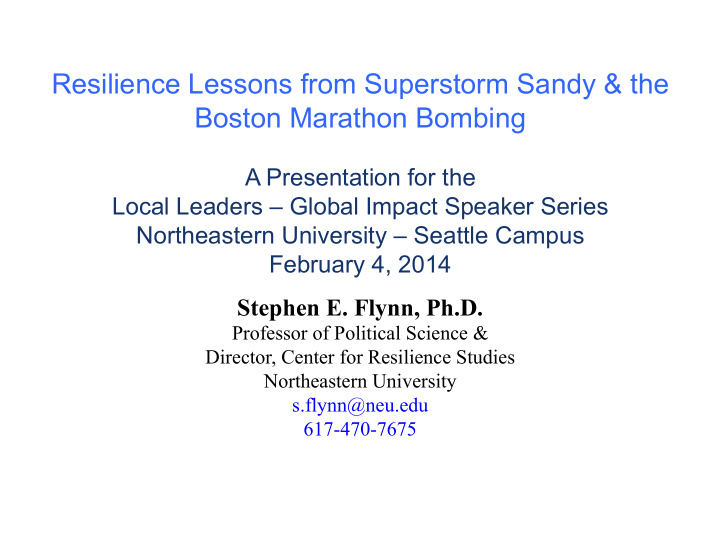



Resilience Lessons from Superstorm Sandy & the Boston Marathon Bombing A Presentation for the Local Leaders – Global Impact Speaker Series Northeastern University – Seattle Campus February 4, 2014 Stephen E. Flynn, Ph.D. Professor of Political Science & Director, Center for Resilience Studies Northeastern University s.flynn@neu.edu 617-470-7675
Superstorm Sandy Stats • October 29, 2012 • 1.3 Million without power a week after the storm hit • Landfall across 21 states • 380,000 homes damaged or • 80 MPH Winds destroyed • 820 Mile Diameter • New York Stock Exchange • 159 Deaths closed for two consecutive • 8.6 Million customers times for the first time since without power across 17 1888 states, from NC to Maine and • Outage of 25% of cell as far West as Illinois towers in 10 states • $18b in federal funds for debris removal
Superstorm Sandy – a “predictive surprise”
Case Study I: Private Sector Resilience: Oct 28, 2012 Citibank Headquarters Goldman Sachs Headquarters 388 Greenwich Street New York, 200 West St. New York, NY NY
Case Study II: Public Sector Resilience Metropolitan Transportation Authority: 1. Moved Trains to high ground and shelter 2. Provided incentive for workforce to stay on the job
Case Study 2: Public Sector Resilience “Experience Can be a Problematic Guide” New Jersey Transit moved trains to Hoboken & Meadowlands so they would be near highest demand users for recovery
Community Resilience and Critical Infrastructure Resilience are National Strategic Imperatives “The term resilience refers to the ability to prepare for and adapt to changing conditions and withstand and recover rapidly from disruptions. Resilience includes the ability to withstand and recover from deliberate attacks, accidents, or naturally occurring threats or incidents.* * President Policy Directive 21 - Critical Infrastructure Security and Resilience February 12, 2013
RESILIENCE FEATURES Pre-event: • Modeling and planning • Situational Awareness • Resistance, Cushionability, Robustness, Redundancy During event: Resourcefulness - response should be done nimbly and competently enough to mitigate consequence and support rapid recovery Post event: • Restore minimal function • Restore full function • Adapt and improve
Performance (Percent) D R 100 80 C A Resilience Parameters 60 B D = Disruption to System B T R = Capability to attenuate or mitigate effect 40 prior to or at time of event A = Capability to absorb and degrade 20 T 1 T 2 T 3 B = Bottom out; Threshold Level 0 B T = Length of time at bottom Time C = Capability to reconstitute back to initial level Source: J. Kahan, et. Al., Risk and Resilience: Exploring the Relationship , Homeland Security Studies and Analysis Institute, Nov 20, 2010 & Mary Ellen Hynes, “Extreme Loading of Physical Infrastructure” presentation at the 4th DHS University Network Summit , March 11, 2010;
10
CONCLUSIONS • Resilience requires greater emphasis on and investment in forecasting, modeling, monitoring, and assessment capabilities that can support mitigation, speed response and recovery, and inform adaptation in the aftermath of disruptive incidents. • When disaster’s strike, the first responders are always local and citizens are indispensible strategic assets. • Large-scale disasters impact regional systems and therefore require an enhanced capacity for undertaking preparedness, response, and recovery at a regional level. • Resilience requires a deeper understanding of interdependencies and the cascading effects that a major disruption can generate. • Companies and communities need to “bake-in” resilience into their critical systems and functions. • Local, regional, and national competitiveness will increasingly be defined by the level of resilience that communities and countries have to withstand, nimbly respond, and rapidly recover from shocks and disruptive events. People will chose to invest in companies and live in areas that possess resilience and gravitate away from those that do not.
Recommend
More recommend